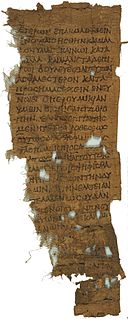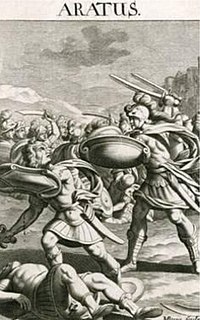Aristratus was a tyrant of the ancient Greek city-state of Sicyon who flourished in the years when Philipp II of Macedon established his hegemony over Greece, probably between 346 and 337 BC.
A tyrant, in the modern English-language usage of the word, is an absolute ruler unrestrained by law, or one who has usurped legitimate sovereignty. Often portrayed as cruel, tyrants may defend their position by oppressive means. The original Greek term, however, merely meant an authoritarian sovereign without reference to character, bearing no pejorative connotation during the Archaic and early Classical periods. However, Plato, the Greek philosopher, clearly saw tyrannos as a negative word, and on account of the decisive influence of philosophy on politics, its negative connotations only increased, continuing into the Hellenistic period.

Ancient Greece was a civilization belonging to a period of Greek history from the Greek Dark Ages of the 12th–9th centuries BC to the end of antiquity. Immediately following this period was the beginning of the Early Middle Ages and the Byzantine era. Roughly three centuries after the Late Bronze Age collapse of Mycenaean Greece, Greek urban poleis began to form in the 8th century BC, ushering in the Archaic period and colonization of the Mediterranean Basin. This was followed by the period of Classical Greece, an era that began with the Greco-Persian Wars, lasting from the 5th to 4th centuries BC. Due to the conquests by Alexander the Great of Macedon, Hellenistic civilization flourished from Central Asia to the western end of the Mediterranean Sea. The Hellenistic period came to an end with the conquests and annexations of the eastern Mediterranean world by the Roman Republic, which established the Roman province of Macedonia in Roman Greece, and later the province of Achaea during the Roman Empire.
A city-state is a sovereign state, also described as a type of small independent country, that usually consists of a single city and its dependent territories. Historically, this included cities such as Rome, Athens, Carthage, and the Italian city-states during the Renaissance. As of 2019, only a handful of sovereign city-states exist, with some disagreement as to which are city-states. A great deal of consensus exists that the term properly applies currently to Singapore, Monaco, and Vatican City. City states are also sometimes called micro-states which however also includes other configurations of very small countries, not to be confused with Micronations.
Aristratus is named twice in Demosthenes speech On the Crown as one of the rulers who favoured the Macedonian king. In the first passage he is called an outcast by the orator. In the second passage he is mentioned together with another Sicyonian called Epichares, but it is not clear whether this man was an assistant, a colleague or a successor. [1]

Demosthenes was a Greek statesman and orator of ancient Athens. His orations constitute a significant expression of contemporary Athenian intellectual prowess and provide an insight into the politics and culture of ancient Greece during the 4th century BC. Demosthenes learned rhetoric by studying the speeches of previous great orators. He delivered his first judicial speeches at the age of 20, in which he argued effectively to gain from his guardians what was left of his inheritance. For a time, Demosthenes made his living as a professional speech-writer (logographer) and a lawyer, writing speeches for use in private legal suits.

On the Crown is the most famous judicial oration of the prominent Athenian statesman and orator Demosthenes, delivered in 330 BC.
The fact that Aristratus was a tyrant is established by Plutarch in his biography of Aratus of Sicyon, where the author narrates the destruction of the former tyrants' portraits in the town hall of Sicyon after the reintroduction of democracy in 251 BC. According to Aratus' own memoirs, the most artful painting showed Aristratus with the goddess of victory Nike on a chariot. Although the artwork was by the hand of the famous painter Melanthius with the collaboration of the even more famous Apelles, Aratus insisted on its destruction, but his friend Nealkes convinced him to safe at least the goddess and cancel only the tyrant's face. Nealkes, a painter in his own right, then painted a palm where Aristratus stood, but forgot his feet which remained visible underneath the chariot. [2]

Aratus was a statesman of the ancient Greek city-state of Sicyon and a leader of the Achaean League. He deposed the Sicyonian tyrant Nicocles in 251 BC. Aratus was an advocate of Greek unity and brought Sicyon into the Achaean League, which he led to its maximum extent. He was elected strategos many times and led the Achaeans against Macedonia, the Aetolians and the Spartans. After the Spartans defeated and nearly destroyed the cities of the Achaean League, he requested Antigonus III Doson of Macedonia to help fight against the Aetolians and Spartans. After Antigonus died in 221 BC, Aratus did not get along with the new king, Philip V of Macedon, who wanted to make the Achaean League subject to Macedonia. Polybius and Plutarch record that Philip had Aratus poisoned.

In ancient Greek religion, Nike was a goddess who personified victory. Her Roman equivalent was Victoria.
Melanthius was an ancient Greek painter of the 4th century BC. He belonged to the school of Sicyon, which was noted for fine drawing.


